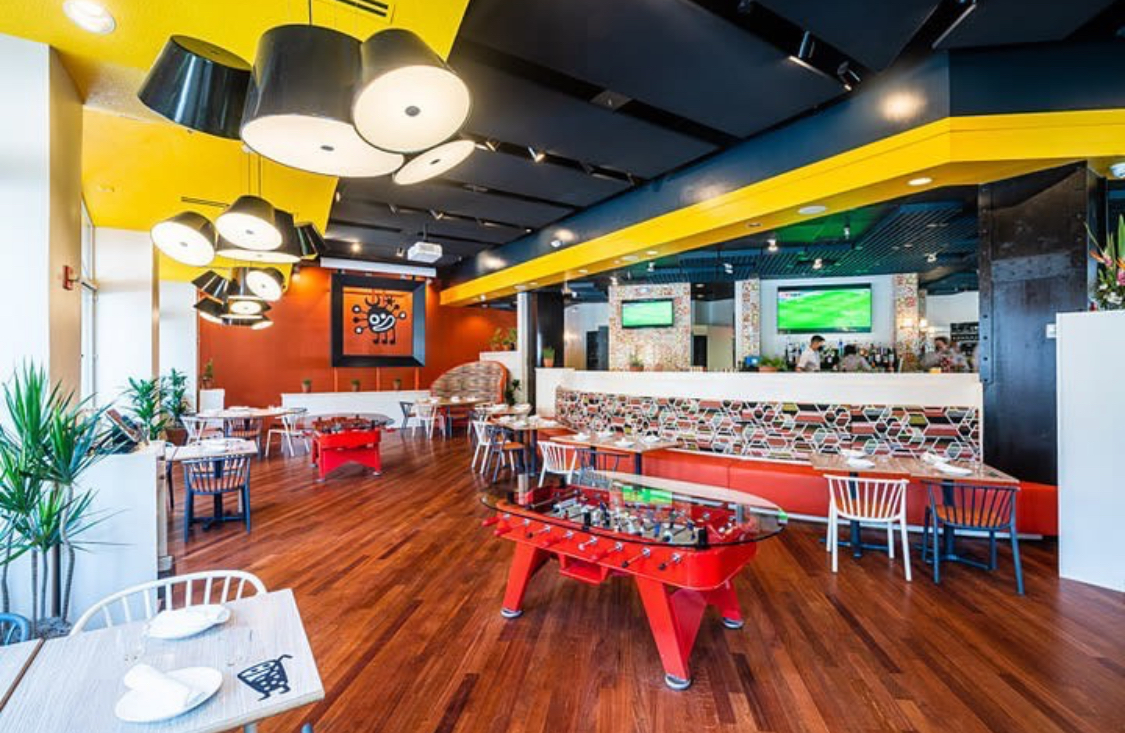Walking into the Spanish Diner in Downtown Bethesda feels like stepping into a restaurant in Spain. From imported Spanish olive oil and canned goods to Horchata (a traditional Spanish drink) and Cola Cao (a Spanish brand of chocolate milk), shelves stocked with an array of traditional goods available for purchase. The TVs on the walls broadcast La Liga soccer games and American sports games on Latino channels. The entire restaurant brims with modern and traditional Spanish culture, providing a taste of home for some and a journey of flavor for others.
The Spanish Diner is one of a series of D.C. restaurants by José Andrés, an internationally renowned chef famous for his skill and humanitarian efforts.
As someone of Spanish origin, I aimed to compare the quality of dishes from the country. Although initially shocked at the high prices, I sought to discover if these authentic plates justified the cost.
Pan con Tomate (Bread with Tomato): 4.5/5
Pan con Tomate is a simple, popular Spanish appetizer consisting of bread, usually baguette, topped with grated tomato and garlic. The bread was fantastic, perfectly toasted and crisp — an ideal base to compliment the toppings. The specific type of bread used at Spanish Diner is pan de cristal (glass bread), a bread native to Barcelona with a crisp crust and airy interior due to its 100% hydrated dough. Like the Italian Ciabatta, this bread is very difficult to make for the inexperienced baker and is rare outside of Spain. The olive oil drizzled on top was bright and fresh and maintained a mild presence within the dish. Disappointingly, the tomato paste lacked flavor, though it was serviceable overall. At $12, the bread’s perfect crunch, combined with the quality extra-virgin olive oil and perfectly ripe tomatoes, partially justified the appetizer’s exorbitant price.
Croquetas de Cocido (Beef, Ham, and Chicken Croquettes): 4/5
Croquetas are finger-sized fried bites with a crust and a meaty, creamy filling. The exterior of the croquettes was crispy without being too doughy or oily, and the filling was savory and still piping hot. The filling was slightly too creamy for my taste and came across as a little runny. At $14, they provided a tasty bite, but I found it harder to excuse the cost for something regarded as typical table fare in Spain.
Gambas al Ajillo (Shrimp Cooked with Garlic): 4/5
This simple dish was cooked perfectly, and the crisp, juicy shrimp was evenly coated in garlic oil. The garlic itself was smooth, sweet and soft all the way through. I appreciated the provision of fresh bread accompanying the dish, as I used it to dip in the savory oil and pile on cloves of roasted garlic. The dish cost $18, and while tasty, it took a lot of work to justify an appetizer-sized portion for so much money.
Ensaladilla Ucraniana (Ukrainian Salad): 3.5/5
Despite the allusion to Ukraine in the name, this is a typical Spanish dish — a potato salad with Spanish canned tuna, carrots, peas and mayonnaise. Though not my favorite dish, I found it a solid take on the traditional meal. It was slightly too creamy, and the acidity from the vinegar was overpowering, but it was tasty overall. It cost $11, which, combined with its uninspiring content, made it the weakest link.
Lubina a la Donostiarra (Donostiarra Sea Bass): 4.5/5
This decadent fish consisted of an oven-roasted Branzino filet of sea bass coated in a sauce from the basque city of Donostia-San Sebastian placed on a bed of roasted onion and confit potatoes. The fish was cooked phenomenally, delectably flaky and buttery and, as I later learned, was originally caught in the Mediterranean before being imported to the United States. The potatoes and onions underneath were tasty as well, and while the sheer quantity of onion might seem baffling, this is accurate to the dish’s spirit — some recipes call for as much as two heads of onion for one fish. I wish I could taste more of the sauce, but what I tasted was delicious. It costs $23, which is more justifiable than many other dishes, considering the imported fish.
Huevos Rotos con Chistorra y Patatas (Broken Eggs with Spanish Sausage and Potatoes): 4.5/5
This is one of the most classic Spanish bar foods out there, featuring eggs cooked sunny-side-up and sausage or ham over fried chunks of potato. The key ingredient in this take, the chistorra, is a traditional smoked pork link sourced from Spain. The egg was cooked very well, with a bright orange, runny yolk spilling over the potatoes beautifully. The fries were crispy and salty without being oily. It cost $17, and while tasty and well-done, the price feels excessive considering its simple, everyday ingredients.
Flan de Mamá Marisa (José Andrés’s mother’s flan recipe): 4.75/5
This famous dessert is made up of three simple ingredients — condensed and evaporated milk, eggs and sugar — yet some small touches can elevate the dish. Smooth and creamy, I’d consider it better than most flans I’ve had in Spain. I often struggle with the large quantity of sugar in the dish, yet Andrés’ take on the dish was one of the most perfectly balanced I’ve ever eaten. Despite how delicious it was, I found the $10 cost absurd, considering the simplicity of the ingredients.





















